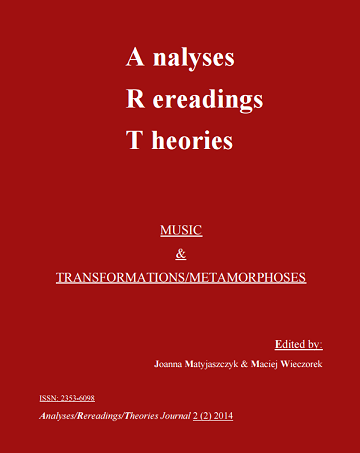The Power of Music in the Tale of Beren and Lúthien by J.R.R. Tolkien
DOI:
https://doi.org/10.18778/2353-6098.2.09Keywords:
Beren, Lúthien, Middle-Earth, music, TolkienAbstract
Tolkien valued music in his private life, and this is mirrored in his works about Middle-Earth, which owes its very existence to music. It is born out of the song of the Ainur. But the role of music does not end with this creative act, rather, it continues to influence the history of Middle-Earth. The paper aims to analyze the role of music in the tale of Beren and Lúthien in the published Silmarillion. The tale of Beren and Lúthien was of personal significance to Tolkien himself. It also includes numerous allusions to music. It is the language of love for both Beren and Lúthien, who make their own songs. Lúthien’s music has power which allows her to overcome Sauron and Morgoth and to win a second life for Beren from Mandos, while Finrod uses music in his duel with Sauron. Music affects both positive and negative characters, including Sauron and Morgoth. Its importance is also emphasized by the existence of professional musicians, such as Daeron, Thingol's minstrel. The story "Of Beren and Lúthien" demonstrates the power of music, which has a huge impact on the entire history of Middle- Earth. Without it, many events would never have happened.
References
Drout, Michael D. C. J.R.R. Tolkien Encyclopedia. Scholarship and Critical Assessment. New York: Routledge, 2007. Print.
Google Scholar
Eden, Bradford Lee. “Music in Middle Earth.” J.R.R. Tolkien Encyclopedia. Scholarship and Critical Assessment. Ed. Michael D.C. Drout. New York: Routledge, 2007. 444-45. Print.
Google Scholar
Eden, Bradford Lee. “The ‘Music of the Spheres’: Relationship between Tolkien’s The Silmarillion and Medieval Cosmological and Religious Theory.” Tolkien the Medievalist. Ed. Jane Chance. London: Routledge, 2003. 183-93. Print.
Google Scholar
DOI: https://doi.org/10.4324/9780203218013-21
Flieger, Verlyn. Interrupted Music: The Making of Tolkien’s Mythology. Kent, OH: Kent State UP, 2005. Print.
Google Scholar
Rateliff, John D. “A Fragment, Detached: The Hobbit and The Silmarillion.” Tolkiendil. N.p., May 2012. Web. 22 July 2014.
Google Scholar
Seaman, Gerard. “Lúthien.” J.R.R. Tolkien Encyclopedia: Scholarship and Critical Assessment. Ed. Michael D.C. Drout, New York: Routledge, 2007. 396-97. Print.
Google Scholar
Scull, Christina and Wayne Hammond, eds. The J.R.R. Tolkien Companion and Guide. London: HarperCollins Publishers, 2006. Print.
Google Scholar
Tolkien, John Ronald Reuel. The Silmarillion. London: Unwin Paperbacks, 1984. Print.
Google Scholar
West, Richard C. “Real-world Myth in a Secondary Story. Mythological Aspects in the Story of Beren and Lúthien.” Tolkien the Medievalist. Ed. Jane Chance London: Routledge, 2003. 259-67. Print.
Google Scholar
Downloads
Published
How to Cite
Issue
Section
License

This work is licensed under a Creative Commons Attribution-NonCommercial-NoDerivatives 3.0 Unported License.









